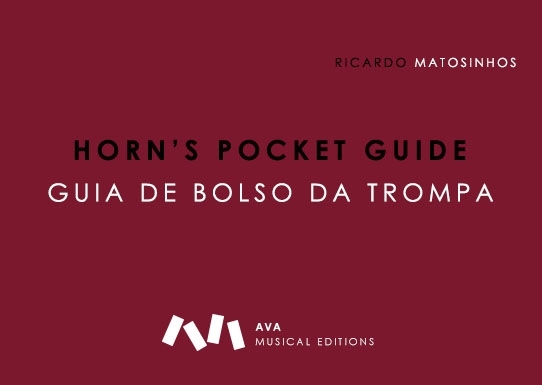Published in June 2010 by AvA Musical Editions
ISMN: 979-0-707730-20-1
|
It's a Pocket Guide (A6 size) to support the horn practice, between classes, where the teacher is not present for helping. English and Portuguese Edition |
TOPICS-The Harmonic Series -How does the Horn works? -The Full Double Horn -Harmonic Series on B flat Side of the Horn -Harmonic Series on F Side of the Horn -Full Double Horn Fingerings and Intonation Tendencies -Bb Horn Standard Fingering -F Horn Standard Fingering -Full Double Horn Whole Tone Lip Trills Fingerings -Whole Tone Harmonics -The right hand on the bell -Horn Transpositions -How to Change a Rotary Valve Cord? |
Reviews
“Here is a handy little reference that can serve a number of purposes. Ricardo Matosinhos, a leading player and teacher in Portugal, compiled this little volume to support the horn player in practice sessions, when the teacher is not present. As he says, "With the knowledge of the instrument and a better understanding of how it works, the horn player can make decisions that may help his technical and interpretive performance." In both English and Portuguese, this book presents quick reference guides to tuning the instrument, the harmonic series for all fingerings on both F and Bb sides of the double horn with intonation tendencies, standard fingerings,whole tone lip trill fingerings, right hand positions for hand-stopping and echo horn, intervals of transposition, and how to change a broken valve string.All the information is presented clearly and concisely, and I think this book accomplishes its goals very well. As a teacher, I tend to worry most about what happens between lessons, and I would feel more comfortable if my students, especially the younger ones, had a reference like this in their cases or book-bags that they would actually use when questions related to these areas come up during practice sessions. I especially like the emphasis on the harmonic series and its obvious relationship to intonation and fingering choices - this is probably the greatest value of this book. I also appreciate the handy chart on transpositions and the instructions for changing a broken string. With this book in hand, there are no more excuses! In all, this is an excellent collection of information related to the stated purpose.”
Jeffrey Snedeker, Music and Book Reviews,
“The Horn Call”, Journal of the International Horn Society, October 2011, Vol XLII, No1
_____
Also reviewed by Bruce Hembd, at hornmatters.com




